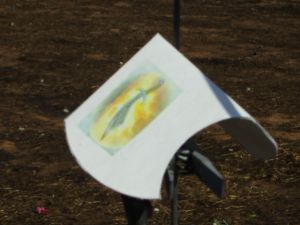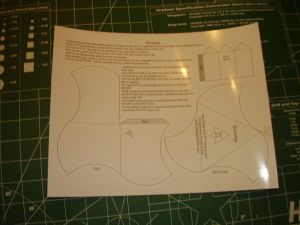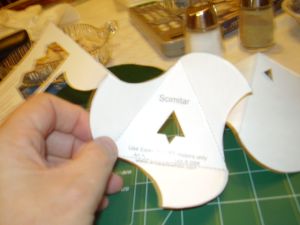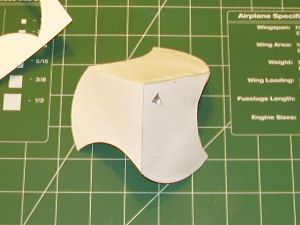Art Applewhite Rockets Scimitar 13mm (Plan)
Art Applewhite Rockets - Scimitar (13mm) {Plan}
Contributed by John Lee
| Construction Rating: | starstarstarstarstar_border |
| Flight Rating: | starstarstarstarstar |
| Overall Rating: | starstarstarstarstar |
| Manufacturer: | Art Applewhite Rockets  |
| Skill Level: | 1 |
| Style: | Pyramid, Saucer |

Brief:
The 13mm Scimitar is a simple rocket made from a paper shroud. It was designed by Art Applewhite and is available
free through his website. All you have to do is download the
PDF file and print it out on suitable stock. The Scimitar spins as it ascends, flips over at apogee and uses
aerobrake recovery.
Construction:
The only real material for the rocket itself is some heavy cardstock on which to print out the PDF file. Other than
that, you will need white glue, a razor knife and a straightedge. The instructions are printed right on the single
sheet PDF file.
Construction is easy. The first step is to locate some suitably heavy cardstock. Art recommends 110lb. I used some of the heavy gloss paper I am using to clone the old Centuri Vulcan. It is not measured in the standard way and is given as 12lb. The paper industry has a very eccentric way of measuring these things but it is slightly heavier than 110lb cardstock.
 After printing, the holes for the engine mount and launch rod are cut out with a razor
knife. The motor mount, upper body and lower body are then cut out. It pays to use a straightedge where possible to
guide the razor knife. The instructions say to use "good scissors" but I like the X-Acto. Unfortunately, the
curves of the shroud mean that a lot of it was cut freehand. I hate doing that!
After printing, the holes for the engine mount and launch rod are cut out with a razor
knife. The motor mount, upper body and lower body are then cut out. It pays to use a straightedge where possible to
guide the razor knife. The instructions say to use "good scissors" but I like the X-Acto. Unfortunately, the
curves of the shroud mean that a lot of it was cut freehand. I hate doing that!
The motor mount is folded into a triangular prism and set apart to dry. The upper body is folded to form a corner. This is easily apparent when you have the thing in front of you, prose does not do it justice. The lower body is then glued into place. It forms an after bulkhead and stiffens the "scimitar blades." After that, it is just a matter of sliding the motor mount into place and gluing it. Care should be taken when installing the lower body to ensure that the launch rod holes line up. Other than that, there are no real gotchas.
PROs: very easy
CONs: cutting curves freehand stinks.

Finishing:
Finishing is not really needed on this rocket. You can print the pattern on any color cardstock you like and have
something that is perfectly reasonable. To me, this is the boring approach. Besides, the glossy paper I used was plane
white.
I looked on the Internet and found some scimitar images I...appropriated. I finally settled on one of a fantasy sword within an oval of clouds. I thought that I would print three of them on decal paper and have the curve of the sword match the curve of the rocket on each side. That was the idea, anyway.
I right clicked the file and saved the JPG. I then loaded it into Photoshop, sized it the way I wanted, and copied it twice to give me a total of three images. I put a piece of clear decal paper in the color laser printer and sent the job off. I got a nice decal sheet out of it.
I then applied a sword to each of the three "fins" of the rocket. The idea sounded good but I am less than thrilled with the result. Still, it looks better than plain old white!
Construction Rating: 4 out of 5

Flight and Recovery:
I launched this at a club event that was almost over for the day. I had 2 plugged motors left so I only got to make
one flight with this rocket since I wanted to launch another one as well. I inserted the A10-PT and off she went. It
was an impressive flight as the rocket spun vigorously all the way up, inverted and spun gently down.
PROs: impressive flight
CONs: Only one suitable motor
Flight Rating: 5 out of 5
Summary:
PROs: Extremely simple, free, and different from all the FNCs.
CONs: None
Overall Rating: 5 out of 5
Other Reviews
- Art Applewhite Rockets Scimitar 13mm (Plan) By John Lee
Brief: Art Applewhite comes up trumps again. Like the 13mm Qubit, the Scimitar is free to download from his website and is easy to build and fly, except this one flies even better. It still uses airbrake recovery, but the flight is much more interesting! Construction: Art's website has two Scimitars to download: one designed in 2004 and one in 2006. The main difference is the ...
 |
 |
Flights
Sponsored Ads
 |
 |











